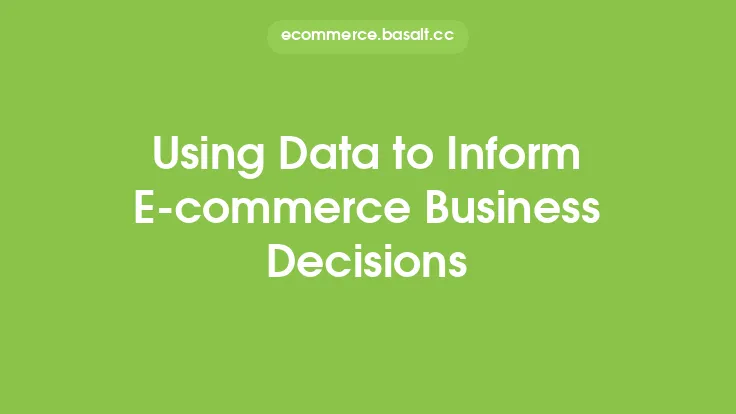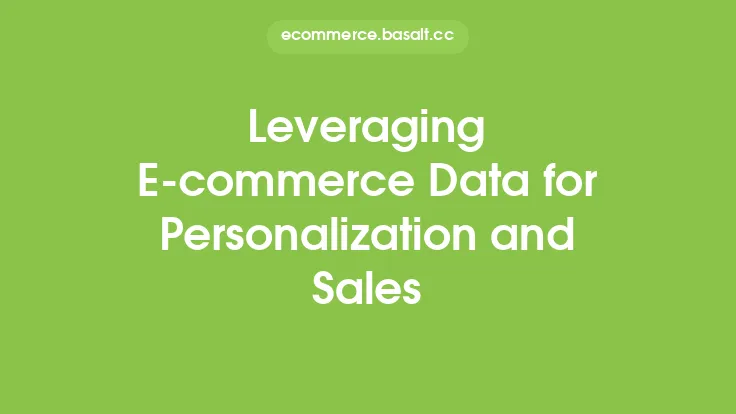In the realm of e-commerce, data is the lifeblood that fuels informed decision-making and strategic planning. One of the most valuable sources of data for e-commerce businesses is their Customer Relationship Management (CRM) system. By leveraging CRM data, e-commerce companies can gain a deeper understanding of their customers, identify trends and patterns, and develop targeted marketing strategies that drive sales, revenue, and growth. In this article, we will explore the ways in which CRM data can be used to inform e-commerce marketing strategies, and provide insights into the benefits and best practices of using CRM data in this way.
Introduction to CRM Data
CRM data refers to the information collected and stored in a CRM system about customers, prospects, and sales interactions. This data can include demographic information, purchase history, browsing behavior, email interactions, and other relevant details. By analyzing CRM data, e-commerce businesses can gain a comprehensive understanding of their customers' needs, preferences, and behaviors, and use this information to inform their marketing strategies.
Benefits of Using CRM Data in E-commerce Marketing
There are several benefits to using CRM data in e-commerce marketing. Firstly, it allows businesses to develop targeted and personalized marketing campaigns that are tailored to specific customer segments. By analyzing CRM data, businesses can identify patterns and trends in customer behavior, and use this information to create targeted promotions, offers, and content that resonate with their target audience. Secondly, CRM data can help businesses to optimize their marketing channels and tactics, by identifying which channels and tactics are most effective in driving sales and revenue. Finally, CRM data can help businesses to measure the effectiveness of their marketing campaigns, and make data-driven decisions about how to allocate their marketing budget.
Types of CRM Data Used in E-commerce Marketing
There are several types of CRM data that can be used in e-commerce marketing, including:
- Demographic data: This includes information such as age, gender, location, and income level.
- Purchase history data: This includes information about customers' past purchases, such as the products they have bought, the frequency of their purchases, and the total amount they have spent.
- Browsing behavior data: This includes information about how customers interact with a business's website, such as the pages they visit, the products they view, and the time they spend on the site.
- Email interaction data: This includes information about how customers interact with a business's email campaigns, such as open rates, click-through rates, and conversion rates.
- Social media data: This includes information about how customers interact with a business's social media presence, such as likes, shares, and comments.
Analyzing CRM Data for E-commerce Marketing Insights
To gain insights from CRM data, e-commerce businesses need to analyze the data using various techniques and tools. Some common techniques used to analyze CRM data include:
- Segmentation: This involves dividing customers into distinct groups based on their demographic characteristics, purchase history, or browsing behavior.
- Clustering: This involves grouping customers into clusters based on their similarities and differences.
- Regression analysis: This involves analyzing the relationship between different variables, such as purchase history and demographic characteristics.
- Predictive modeling: This involves using statistical models to predict future customer behavior, such as the likelihood of a customer making a purchase.
Using CRM Data to Inform E-commerce Marketing Strategies
CRM data can be used to inform a wide range of e-commerce marketing strategies, including:
- Email marketing: By analyzing email interaction data, businesses can optimize their email campaigns to improve open rates, click-through rates, and conversion rates.
- Social media marketing: By analyzing social media data, businesses can optimize their social media presence to improve engagement, reach, and conversions.
- Content marketing: By analyzing browsing behavior data, businesses can optimize their content to improve engagement, time on site, and conversions.
- Paid advertising: By analyzing purchase history data, businesses can optimize their paid advertising campaigns to improve return on ad spend (ROAS) and conversion rates.
Best Practices for Using CRM Data in E-commerce Marketing
To get the most out of CRM data, e-commerce businesses should follow several best practices, including:
- Ensuring data quality: This involves ensuring that CRM data is accurate, complete, and up-to-date.
- Using data visualization tools: This involves using tools such as charts, graphs, and heat maps to visualize CRM data and gain insights.
- Segmenting data: This involves dividing CRM data into distinct segments to gain a deeper understanding of customer behavior and preferences.
- Using predictive analytics: This involves using statistical models to predict future customer behavior and optimize marketing campaigns.
- Integrating CRM data with other data sources: This involves integrating CRM data with other data sources, such as social media data and website data, to gain a comprehensive understanding of customer behavior and preferences.
Common Challenges and Limitations of Using CRM Data in E-commerce Marketing
While CRM data can be a powerful tool for informing e-commerce marketing strategies, there are several common challenges and limitations to using it, including:
- Data quality issues: Poor data quality can limit the accuracy and reliability of CRM data, making it difficult to gain insights and make informed decisions.
- Data integration challenges: Integrating CRM data with other data sources can be challenging, particularly if the data is stored in different formats or systems.
- Limited resources: Small and medium-sized businesses may not have the resources or expertise to analyze and act on CRM data.
- Changing customer behavior: Customer behavior and preferences can change rapidly, making it challenging to keep CRM data up-to-date and relevant.
Future of CRM Data in E-commerce Marketing
The use of CRM data in e-commerce marketing is likely to continue to evolve and grow in the future, driven by advances in technology and analytics. Some potential future trends and developments include:
- Increased use of artificial intelligence (AI) and machine learning (ML) to analyze CRM data and predict customer behavior.
- Greater integration of CRM data with other data sources, such as social media data and website data.
- Increased use of data visualization tools to visualize CRM data and gain insights.
- Greater emphasis on data quality and accuracy, to ensure that CRM data is reliable and trustworthy.
Conclusion
In conclusion, CRM data is a powerful tool for informing e-commerce marketing strategies, allowing businesses to gain a deeper understanding of their customers, identify trends and patterns, and develop targeted marketing campaigns that drive sales, revenue, and growth. By analyzing CRM data, e-commerce businesses can optimize their marketing channels and tactics, measure the effectiveness of their marketing campaigns, and make data-driven decisions about how to allocate their marketing budget. As the use of CRM data in e-commerce marketing continues to evolve and grow, businesses that leverage this data effectively will be well-positioned to succeed in a rapidly changing and competitive market.





